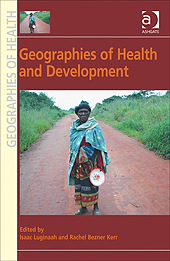Geographies of Health and Development

This book provides an overview of health geography, the sub-field of human geography that applies to medicine and health. The cases are very varied. For instance, one chapter explores the limited resources and geographical challenges (e.g. flooding) affecting assessment of malaria treatment options in Sierra Leone. And one section traces the effects on globalization and urbanization on local health issues, including tuberculosis. The case studies are brief, encouraging readers to seek out further information on the particular cases that interest them.
Certain patterns can be observed across these diverse contexts. One is that social inequalities tend to worsen and contribute to health inequalities, as with aboriginal populations in Canada. Aboriginal people have higher rates of both hunger and obesity than other Canadian groups, creating a kind of double burden of poor nutrition. The chapter on aboriginal people in Canada further disaggregates the health circumstances of aboriginal youth, showing how socioeconomic conditions such as racism and poverty both aggravate and are exacerbated by high incidences of substance abuse, suicide, HIV infection, and other negative outcomes.
These kinds of multiple inequalities can exist both within a country and across countries. For example, the shortage of health care workers in South Africa is affected by their migration to the UK (among other wealthy countries). Attempts have been made by both nations to reduce such migration for the sake of South African health care, but with limited success.
Another pattern that emerges from these cases is the central importance of context in determining health needs, conditions and possible interventions. For example, one chapter explores why health insurance might not be a good fit for Ghana’s cultural context (where insurance is insufficiently socially inclusive). Another explains why poor residents of Chennai, India might prefer private health care (it is often perceived as a better long-term investment than poor-quality public care, which runs counter to the belief that poor people are only motivated by short-term thinking). These cases show the limits of one-size-fits-all assumptions – e.g. that public health care is always better for the poor, or that insurance is the best private sector model for health care delivery.
Therefore, Geographies of Health and Development argues overall that it is crucial to understand how geography acts as a determinant of health. It is not surprising that there is a strong relationship between health and development, where poor health challenges development and insufficient development impairs health. The many cases sampled in this book make the case for carefully thinking through these links so that global public health is as effective and inclusive as possible.
Further reading:
Atkinson, Sarah J (1993), “Urban health in the Third World: a guide to the literature”, Environment and Urbanization Vol 5, No 2, pages 146–152, available at http://eau.sagepub.com/content/5/2/146.refs.
Environment and Urbanization (2011), “Health and the City”, Vol 23, No 1, available at http://eau.sagepub.com/content/23/1.toc.
Satterthwaite, David (2011), “Editorial: Why is urban health so poor even in many successful cities?”, Environment and Urbanization Brief 22, 6 pages, available at http://pubs.iied.org/10595IIED.html?s=EUB.
Book note prepared by Christine Ro
Search the Book notes database
Our Book notes database contains details and summaries of all the publications included in Book notes since 1993 - with details on how to obtain/download.
Use the search form above, or visit the Book notes landing page for more options and latest content.
For a searchable database for papers in Environment and Urbanization, go to http://eau.sagepub.com/

